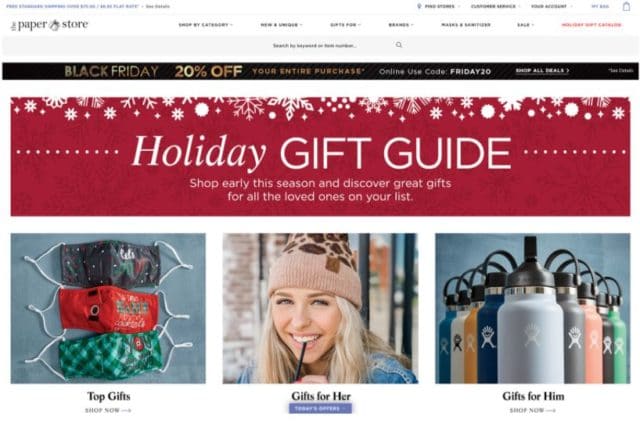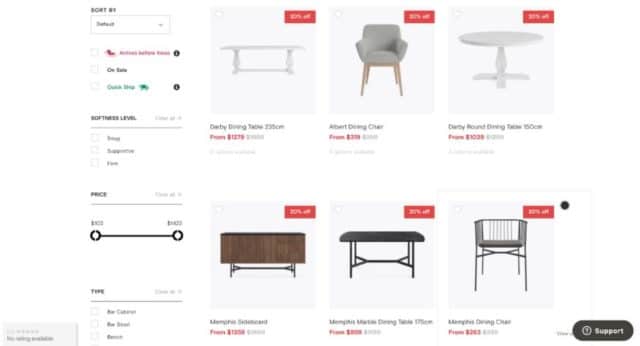It’s not surprising that consumers are spending $1 out of every $5 online, since the COVID-19 pandemic has made online shopping a safer alternative to the brick-and-mortar experience. As a result, ecommerce sales have increased by 32% in 2020, reaching heights that experts had predicted for 2022. Online shopping is here to stay, and it’s only gaining momentum. Online visual merchandising is your secret weapon for staying competitive in the new era of ecommerce.
Follow these six online visual merchandising best practices to revolutionize your landing pages, category pages, product pages, and search results. With these techniques, you’ll boost conversion rates, increase average order values, and keep shoppers coming back.
Online visual merchandising tips for landing pages
Here’s how to optimize your customer’s online shopping experience when it begins on your homepage or a landing page.
1. Seek inspiration from brick-and-mortar shops
While ecommerce is only a couple of decades old, the art of visual merchandising has been around for much longer in brick-and-mortar stores. Adapt traditional merchandising strategies for the online shopping experience.
For example, think of your homepage as your digital window display. Rather than placing racks of clothing in this prime real estate, clothing stores create eye-catching arrangements in their front windows. Instead of publishing white background product shots on your homepage, use editorialized photos to highlight new or seasonal products. Check out these other tips for using brick-and-mortar to inspire your online merchandising.
2. Curate landing pages for specific campaigns
The basic ecommerce experience no longer cuts it for savvy online shoppers. They expect more than just category pages for browsing your inventory. Go above and beyond by curating landing pages for specific campaigns.

Rather than letting customers search for holiday gifts on your website, for example, use online visual merchandising to highlight gift ideas. Create gift guides, as The Paper Store does, by curating items into categories like “gifts for her,” “top gifts,” and “gifts under $25.” Editorialize the online shopping experience to make it easier for customers to add items to their carts.
Best practices for search results and category pages
After visiting a landing page, your customer might begin focusing their shopping quest by searching for specific types of products. Here’s how to use online visual merchandising to get them closer to adding items to their cart from a search results page or category page.
3. Customize search results and category pages
If it feels like the customer is in the driver’s seat and you have no control over what they find when they search for products, your online store may be missing critical functions. With the right online visual merchandising tool, you can customize search results pages and category pages based on business priorities.
For example, you should be able to boost high-margin items so when a customer searches for “red sneakers,” your website displays the most profitable pairs before the less profitable options. This technique makes it possible for you to maximize earnings from every customer. Alternatively, you can boost best sellers or sale items depending on your shopper demographic or current business objectives.
4. Use promotional banners and badges
While profitability probably isn’t a product feature you want to share with customers, certain features are beneficial to highlight. Use promotional banners and badges to make items stand out.

Online furniture store Brosa uses badges to draw attention to products that are on sale. They also label fresh inventory with a “new item” badge and designate sale items with a badge that shows the discount amount on search results and category pages. These badges give shoppers reason to pause and more closely examine pieces that they may have otherwise overlooked.
This digital merchandising strategy is most powerful when tied to your social media and email campaigns for a seamless, omnichannel marketing experience.
Online visual merchandising best practices for product pages
Your online shopper finds an item they want to know more about and opens a product detail page (… or, more realistically, opens dozens of product pages in new tabs). Now’s your chance to wow this digital window shopper so that they become a paying customer.
5. Put products into context
Images can make or break a sale. Rather than just displaying white background photos on your product pages, include styled shots that put products into context. This visual aid helps customers picture themselves using your products, and gets them closer to making a purchase.
Let’s say you run an ecommerce store that specializes in tablewares. Why not stage a dinner party using your products and add those images to product pages?
This strategy doubles as a cross and upselling technique. When you highlight multiple products in a photo, customers become more likely to add items to their carts that they may not have originally been looking for.
6. Feature your customers
Another strategy for boosting sales by helping customers envision themselves using your merchandise is to include online visual merchandising on product pages. Why not make your customers the stars of the show? According to recent user-generated content stats, two-thirds of consumers believe and trust the onions of other consumers posted online.

Feature customer photos on your product pages, either in reviews or in an “as seen on” section. Fabletics does a great job of implementing this by sharing photos of customers wearing their workout gear.
If you sell clothing, this ecommerce merchandising technique also helps customers see how your apparel looks on different body types, which can ultimately be what makes the sale.
Online visual merchandising is the key to maximizing revenue in the competitive world of ecommerce
Merchandising can be the difference between an ecommerce website that doesn’t convert, and one that sees explosive growth. When you pair brick-and-mortar merchandising techniques with rule-based online visual merchandising strategies, you’ll be able to turn visitors into high-paying customers and keep them coming back.
Want to get one step closer to unlocking your ecommerce superpowers? Request a demo of Searchspring to learn how these tactics could apply to your store.

